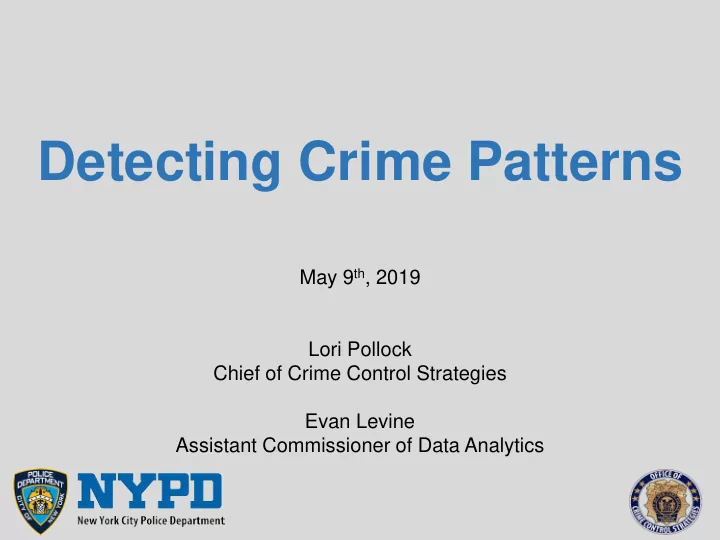

Detecting Crime Patterns May 9 th , 2019 Lori Pollock Chief of Crime Control Strategies Evan Levine Assistant Commissioner of Data Analytics
What is a crime pattern? “A series of crimes committed by the same offender or group of offenders … To identify true patterns, one would need to consider information beyond simply time and space , but also other features of the crimes, such as the type of premise and means of entry .” - Wang et al 2013
Organizational Challenge Tens of thousands of complaints reported each year. When a new complaint is reported, analysts in each precinct are tasked with identifying related complaints. These patterns, after review, inform NYPD operations.
Patternizr helps us meet this challenge • Designed for robberies, burglaries, and grand larcenies • Built into the Domain Awareness System • Patternizr helps the analyst make decisions, it does not make decisions for the analyst
Supervised Machine Learning Historical patterns (~10,000 of each crime type) Training patterns Validation patterns Features Complaint pair extracted from similarities complaint pairs Random forest generation
What is a Random Forest? Derived from classification trees which rely on features. For example: Round? Yes No Yellow? Apple Yes No Banana Carrot Patternizr uses features to classify complaint pairs. The output of Patternizr is the probability that a pair of complaints are in a pattern together.
Reported to 73 Pct P.O. at 1900 HRS P.O. records information about the crime: • Time of occurrence • Place of occurrence Structured • Premise type fields • Property taken • Suspect description • Perpetrator’s statements Unstructured text • Narrative of what happened • Etc.
What features does Patternizr use?
Deployment and Production Process 1a. Train algorithm 1b. Test accuracy and fairness Iterate 1c. Prune features 2. Perform historical load 3. Integrate into Domain Awareness System 4. Train analysts 5. Perform differential loads and monitor usage
Approximately 1/3 of test patterns perfectly rebuilt, and approximately 4/5 at least partially rebuilt.
Efficiency of Patternizr vs. a simple baseline
Safeguards ensure Patternizr is used fairly • Sensitive attributes were hidden from the algorithm. • Outputs of the algorithm were tested for fairness. • Several layers of analytic and supervisory review required.
Recommend
More recommend